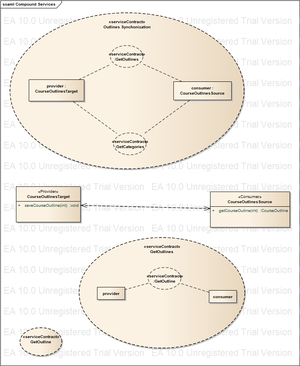SoaML - Extras
Jump to navigation
Jump to search
Connecting Services
TODO: ServiceChannel, Assemply
Quiz
A request:
- is logically the conjugate type of the provider
- is logically the conjugate type of the consumer
A request:
- is the use of the service interface
- is the use of the request interface
A ServiceInterface can be used to type:
- only service port
- only request port
- both if used a conjugated type
The <<Provider>> and <<Consumer>> stereotypes are used on:
- Classes
- Interfaces
- Ports
- CollaborationUse
The isConjugated property must be set to true for which element:
- Every Port
- Service Port
- ServiceInterface
- Request Port
Which of the elements below can type a port in SoaML?
- Consumer
- Milestone
- Provider
- Interface
- ServiceInterface
- Participant
Further Questions
- What kind of elements can appear on ServiceArchitecture?
- What kind of elements can appear on ServiceContracts?
- What kind of types a Service or Request can have?
Extra Exercises
- Design a payment scheduling system (i.e. a person can schedule a payment for a specific date)
- used vocabulary: payment, notification
- Design Service Architecture
- Design Contracts
- Design interfaces
- Design service choreography using:
- state machine
- activity diagram
- sequence diagram
Exercises
- Design an ATM withdrawal:
- service interfaces
- ports
- service contract
- collaboration
Vocabulary you can use:
- Withdraw
- Authorize
- Validate Pin
- Reject
- Customer
- ATM
- Bank
- Visa
Further Reading
Icons Cheat-sheet
Compound service contract
Create a compund contract Purchasing Service.
Vocabulary: Seller, Buyer, Place Order, Returns Service
Show the ports on the consumers and the provider.

